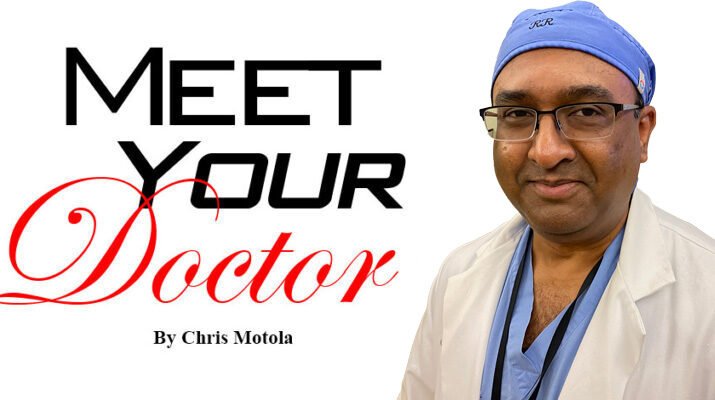Neurosurgeon at Crouse: ‘With the kinds of treatments we’ve started for strokes, the disability and death rates are coming down’
By Chris Motola
Q: We wanted to lead in on the topic of stroke with Fleetwood Mac singer Christine McVie who recently died of a stroke at 79. How common a cause of death is that for a woman of her age?
A: If you look at stroke statistics that we have, about 87% of stroke patients have the kind of stroke that happened to the singer. These are called ischemic strokes. So we’re talking about over 800,000 people in the U.S. every year are having these kinds of strokes. To put it in perspective, that’s one stroke every 40 seconds and one person dies of a stroke every four minutes. So it’s a fairly common cause of death. It’s the fifth leading cause of death in the U.S.
Q: Have these statistics been fairly consistent over time?
A: Hopefully with the kinds of treatments we’ve started for strokes, the disability and death rates are coming down, but it’s still far too many.
Q: What characterizes an ischemic stroke?
A: There are two main types of stroke. Ischemic is the most common and happens in about 85%- to 90% of stroke cases. The remaining are hemorrhagic strokes, which includes bleeding in the brain or subarachnoid hemorrhages from aneurisms. Ischemic strokes happen due to lack of blood flow to the brain from whatever cause, usually because there’s plaque build-up in the arteries or clot that forms from some other source and goes into the brain, blocks the arteries that go into the brain and causes a stroke.
Q: Is stroke mainly a consequence of the same conditions that cause heart attacks? Things like atherosclerosis?
A: Yeah, exactly. If you look at heart disease, atherosclerosis due to basic medical conditions like high blood pressure, high cholesterol, obesity, diabetes, smoking are all major causes. It’s the same for strokes as well. Cardiac disease itself is a very common cause of ischemic strokes. Clots that are formed within the heart can go to the brain and cause an ischemic stroke, so there’s a very big overlap between heart disease and stroke.
Q: Where do the causes diverge?
A: There are other causes for ischemic strokes as well, like some patients who have hypercoagulative diseases. They’re more prone to strokes as well because their blood is basically a lot more prone to clotting. Or in patients who have cancer. They have a tendency toward hypercoagulability. So they can build up a stroke in isolation without necessarily having any cardiac issues.
Q: I noticed in the case of McVie, she also had a cancer diagnosis.
A: Yeah, she did. Although it also appears that she had atrial fibrillation, so it’s very difficult to pinpoint which was the likely cause, but the fact that she had a thrombus in the heart probably makes it likelier.
Q: To what degree is modern stroke care preemptive? Or is it mainly interventional?
A: Preemptive care is a huge component of stroke. If you can prevent the eventuality of a stroke, it obviously makes a huge difference for both the patient and the cost to society. So when it comes to prevention it’s managing diabetes, cholesterol levels, smoking cessation, obesity reduction, exercise, anti-platelets which help reduce the formation of clots, and routine screening of carotid arteries for any blockages. And timely intervention as needed. These make a big difference in reducing the number of strokes.
Q: On the interventional side, how quickly do you need to act to minimize or prevent damage from a stroke?
A: When it comes to stroke, time is of the essence. Every second you’re looking about 32,000 brain cells that are dying. So time is of extreme importance. The first thing is recognizing when someone is having a stroke. We have an acronym called FAST. F is for face weakness or droop. A is for arm or leg weakness. S is for slurred speech. And T is for time to call 911 if you noticed any of these symptoms. Once you get to a place like Crouse, which is a comprehensive stroke center, everything moves very, very quickly. We have a separate code for patients having a stroke. It’s like an alarm for different people: emergency physicians, imaging units, etc. They stop doing whatever they’re doing and don’t take any other patients until the stroke patient has been imaged. The same pager goes to neurosurgeons, neuro-interventional radiology techs and nurses; everyone involved in treating stroke. So stroke patients are immediately reviewed by the emergency team, patients are rushed to the CT scan unit where they are scanned to make sure it’s not a bleed in the brain.
Q: What’s the next steps?
A: Once [the stroke] is confirmed, they undergo vascular imaging to see if there’s a large vessel occlusion, which is crucial. And they also have a profusion scan, which basically tells us what damage has already happened, and what kind of damage can happen if action is not undertaken. The area at risk but not yet damaged is called the penumbra. So if there’s a large penumbra and a large vessel occlusion, patients are given clot-busting drugs before intervention. They’re rushed to undergo a mechanical thrombectomy where we either use large-bore catheters to suck out the clot or stent-retrievers, which are metal meshes which can catch the clot and help us pull it out to hopefully open the artery. The faster we do all this, the better the outcomes.
Note: MBBS are MD-equivalent degrees given by medical schools that follow the United Kingdom medical education system. The acronym is derived from Latin and mean “bachelor of medicine, bachelor of surgery.”

